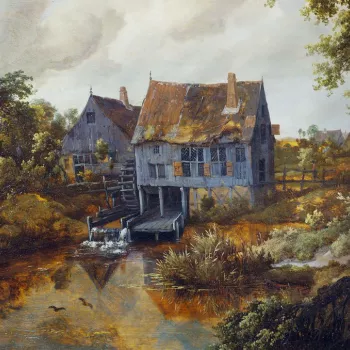Figures on the Coast at Scheveningen Signed and dated 1660
OIl on canvas | 38.2 x 50.0 cm (support, canvas/panel/stretcher external) | RCIN 404802
-
Adriaen van de Velde (1636-72) lived and worked in Amsterdam; he trained with his father, the marine painter Willem van de Velde the Elder, and Jan Wijnants. He was one of the most prolific providers of figures for the landscape paintings of his colleagues, including Jan van der Heyden, Ruisdael, and Hobbema. This is one of a group of Scheveningen beach scenes, the earliest now in the Museumslandschaft Hessen Kassel, which demonstrate more clearly than his later work his relationship with his elder brother, Willem van de Velde the Younger, whose Calm (RCIN 405328) was painted a few years previously.
The Dutch at this time were the first to think of the ‘seaside’ in the modern sense; Adriaen van de Velde’s group of paintings is the first to show what would become Europe’s favourite holiday activity. Previous images of Scheveningen, such as Simon de Vlieger’s of 1633 in the National Maritime Museum, London, depict working fishermen. The majority of figures in van de Velde’s beach scenes on the other hand are obviously middle class and enjoying their leisure. On the left a city family sit in one of the huts, which may be intended for bathers or fishermen; another couple ask directions; another are carried past the inevitable man begging in a hired cart with open sides, where it takes its passengers along the sea’s edge. Behind a decorously amorous couple can be seen a pair of horsemen riding along the strand and some bathers. There is some industry – a barefooted fisherman carries a basket of fish; others mend boats – but already tourism appears to be a more profitable enterprise.
Signed and dated: 'A. V. Velde. f. / 1660'Provenance
Purchased by George IV from Sir Thomas Baring as part of a group of 86 Dutch and Flemish paintings, most of which were collected by Sir Thomas’s father, Sir Francis Baring; they arrived at Carlton House on 6 May 1814; recorded in the anti-room to the Dining Room at Carlton House in 1819 (no 88); in the Picture Gallery at Buckingham Palace in 1841 (no 35)
-
Medium and techniques
OIl on canvas
Measurements
38.2 x 50.0 cm (support, canvas/panel/stretcher external)
53.2 x 64.3 x 5.5 cm (frame, external)
Category
Object type(s)
Other number(s)









